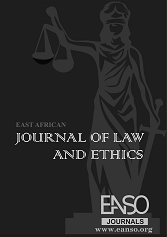Pre-emptive Use of Force in Self-Defence Under International Law
Abstract
Pre-emptive use of force in self-defence is one of the most controversial areas under International Law. States attack each other even if the attack appears more distant. The Right of self-defence can only be invoked against an armed attack. Pre-emptive use of force allows states to use coercive measures against perceived future threats. This type of self-defence is used by the states prior to an armed attack which is contrary to the UN Charter. The defending states do not follow the requirement of necessity and proportionality when using force. The Research Questions were to what extent Pre-emptive use of force under International Law is legal and to what extent Pre-emptive use of force in self-defence is stipulated under the United Nations Charter. The objectives were to examine if Pre-emptive use of force under International Law is Legal and to examine if Pre-emptive Use of force in self-defence is stipulated under the United Charter. The study findings based on Primary Data have shown that Pre-emptive use of force in self-defence is not legal under the UN Charter 1945. Also, it was found that Pre-emptive use of force in self-defence under international Law is not stipulated anywhere in the United National Charter of 1945. Also, it was found that the UN Charter does not allow states to defend themselves in pre-emption of an armed attack where there is no actual armed attack or imminent threat. The study recommends that Pre-emptive use of force in self-defence could now be appropriate due to advanced technology, like Artificial Intelligence and cyber attacks. Also threats of terrorism and non-state Actors. The UN Charter should be amended to copy modernized warfare
Downloads
References
Anthony A. The Use of Force beyond the United Nations Charter Paradigm, London: Routledge, 2016
Deeks A. The Doctrine of Pre-emption, the Oxford Handbook, 2016
Garner B. Black’s Law Dictionary 8th ed. 2004
James M. and Charles O. (2006), Anticipatory Self-Defence: A Discussion of International Law Hanse Law Review, 2016
Joshua R. Iraq Attack can be justified as Collective Self-Defense, 2002
Jakobsen T. et al A Rational Actor Approached to the US-led Invasion of Iraq, 2009
John Q. The Afghanistan War and Anticipatory Self-Defense, 2013. Rev. 541
Van De Hole (2003), ’Anticipatory Self-Defense under International Law’’ American University International Law Review 201319 No.1
Verma S. An Introduction to Public International Law, Prentice Hall of India, New Delhi, 20
JOURNAL
Gathii J. (2005) ’Assessing claims of the new doctrine of Preemptive war under the doctrine of Sources’’ Osgood Hall Law Journal 43.1/2 (2005).
Rivkin D. et al (2005) War, International Law and Sovereignty: Reva-wanting the Rules of the Game in a New Century – Preemption and the law in the twenty first century’ (2005) Chicago Journal of International Law. Force in International Law
INTERNATIONAL INSTRUMENT
The United Nations UN Charter, 1954
The Geneva Conventions 1949
The Statute of the International Court of Justice;
The Covenant of the League of Nations;
The Kellogg-Briand Pact;
The Vienna Convention on the Law of Treaties;
The Rio Treaty of 1947
CASES
Military and Paramilitary Activities in and Against Nicaragua (Nicaragua v. U.S.), 1986 ICJ;
Legality of the Threat or Use of Nuclear Weapons, Advisory Opinion, 1996 ICJ;
Oil Platforms (Iran v. U.S.), 2003 ICJ;
Legality of the Threat or Use of Nuclear Weapons, Advisory Opinion, 1996 ICJ; Oil Platforms (Iran v. U.S.), 2003 ICJ;
Armed Activities on the Territory of the Congo,( Uganda v. Congo) 2005 ICJ;
The Legal Consequences of the Construction of the Wall in the Occupied Palestinian Territory, 2003 ICJ;
INTERNET SOURCES
https://www.aljazeera.com/search/the%20beginning%20of%20russia%20-ukraine%20war accessed on 12/04/2024
https://unis.unvienna.org/unis/en/topics/international-law.htmlaccessed on 16/04/2024
https://www.aljazeera.com/search/the%20beginning%20of%20russia%20-ukraine%20war accessed on 12/04/2024
Copyright (c) 2025 Richard Siame

This work is licensed under a Creative Commons Attribution 4.0 International License.




























